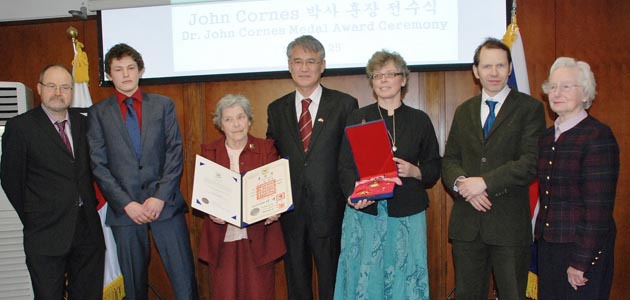Five years since the COI, what progress on North Korean human rights? | NK News
Five years since the COI, what progress on North Korean human rights?
Experts weigh in on the long-term impact of the Commission of Inquiry
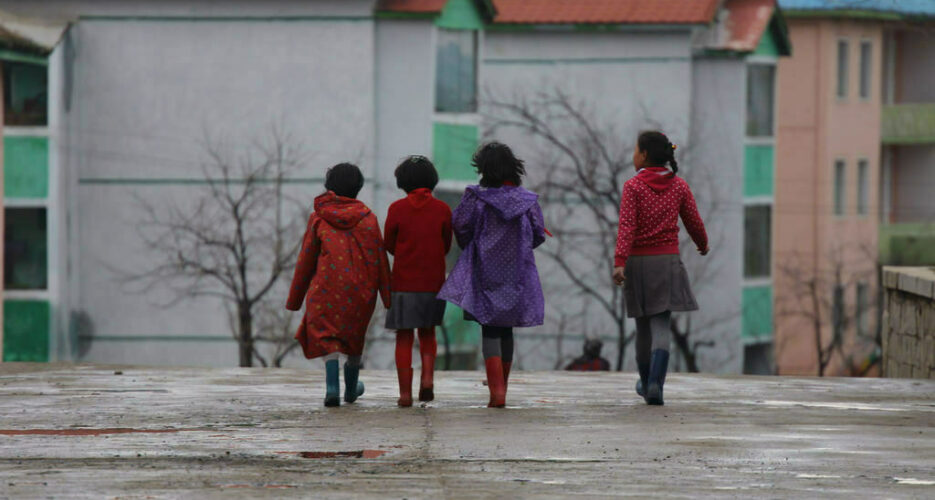
SHARE
Oliver Hotham February 7, 2019
Image: by nknews_hq on 2018-04-07 10:12:05
This month marks five years since the release of the United Nations Commission of Inquiry’s report on North Korean human rights, a landmark document which found the DPRK responsible for innumerable crimes against humanity and violations of the right to life.
Gathered through testimony of more than 100 people, including victims, witnesses and experts and satellite imagery, the report’s release was also widely hailed as a turning point in international recognition of North Korea’s human rights problem — and saw Kim Jong Un himself warned that he could be personally referred to the International Criminal Court.
But, five years on, has momentum stalled? And, amid an ongoing diplomatic detente between North Korea and the U.S. and plans for second summit between Kim and U.S. President Donald Trump already underway, what can be done to bring the human rights back to the forefront of the discussion?
The following experts responded in time for NK News‘s deadline:
Greg Scarlatoiu, Executive Director at the Committee for Human Rights in North Korea
Joanna Hosaniak, Deputy Director General at Citizens’ Alliance for North Korean Human Rights
Teodora Gyupchanova, Director of International Communications at the Database Center for North Korean Human Rights (NKDB)
Sokeel Park, Director of Research & Strategy at Liberty in North Korea
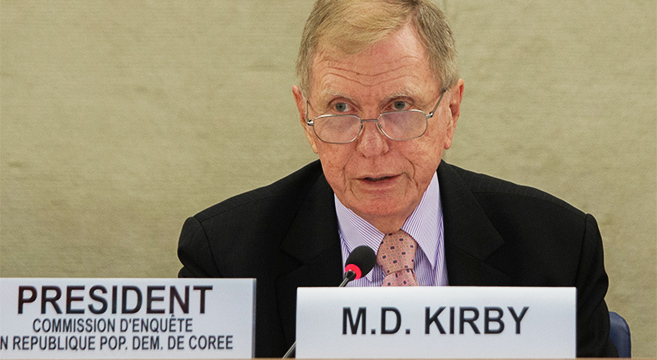 The commission was led by Michael Kirby, a veteran Australian judge | Photo: UN
The commission was led by Michael Kirby, a veteran Australian judge | Photo: UNFive years on, what do you think was the greatest long-term impact of the commission of inquiry?
 Greg Scarlatoiu: The greatest impact of the UN COI report is that paragraphs on accountability and ICC referral were included in annual resolutions of the UN Human Rights Council and the UN General Assembly ever since.
Greg Scarlatoiu: The greatest impact of the UN COI report is that paragraphs on accountability and ICC referral were included in annual resolutions of the UN Human Rights Council and the UN General Assembly ever since.North Korean human rights was also placed on the agenda of the UN Security Council in December 2015, 2016 and 2017.
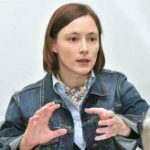
Joanna Hosaniak: The acknowledgement of the international community that violations in North Korea are not mere excesses of the government’s power, but are entrenched in the institutionalized criminal system committing crimes against humanity with a full knowledge and approval of the Worker’s Party and Kim Jong Un.
 Teodora Gyupchanova: The greatest long-term impact of the Commission is the establishment of the fact that severe human rights violations, even ones amounting to crimes against humanity, are actually being perpetrated in the DPRK.
Teodora Gyupchanova: The greatest long-term impact of the Commission is the establishment of the fact that severe human rights violations, even ones amounting to crimes against humanity, are actually being perpetrated in the DPRK.Before the Commission of Inquiry performed its investigation and released its final report there hardly existed a document that was credited in the same way as a piece of evidence of the human rights violations perpetrated by the North Korean regime. All important achievements that we have seen as a result of the COI can be viewed as aftereffects of the conviction of the international community that the human rights situation in the DPRK is critical without the shadow of doubt.
 Sokeel Park: The COI process did not unearth many new insights about North Korea that close observers didn’t already know, however it did very effectively bring a lot more global attention to the gravity and scale of human rights violations in North Korea.
Sokeel Park: The COI process did not unearth many new insights about North Korea that close observers didn’t already know, however it did very effectively bring a lot more global attention to the gravity and scale of human rights violations in North Korea.This remains its biggest impact and legacy: raising the importance of human rights as an agenda and framework to be emphasized when dealing with North Korea.
 The commission warned Kim Jong Un that he could be referred to the International Criminal Court | Photo: Kevin Lim / Straits Times
The commission warned Kim Jong Un that he could be referred to the International Criminal Court | Photo: Kevin Lim / Straits TimesWhat progress do you see towards implementing some of the COI’s recommendations?
 Greg Scarlatoiu: The establishment of the Seoul office of the UNHCHR was the direct result of the COI’s recommendations. Calls for accountability at UN fora were also the result of the UN COI.
Greg Scarlatoiu: The establishment of the Seoul office of the UNHCHR was the direct result of the COI’s recommendations. Calls for accountability at UN fora were also the result of the UN COI. Teodora Gyupchanova: In the first 2-3 years after the report of the commission was released we saw an avalanche of steps towards making its recommendations come to life.
Teodora Gyupchanova: In the first 2-3 years after the report of the commission was released we saw an avalanche of steps towards making its recommendations come to life.To name some of these: a local OHCHR office was established in Seoul and now deals exclusively with monitoring the human rights situation in the DPRK, the accountability project was launched at OHCHR and has developed into a group of experts and a repository set up with the aim of identifying evidential material and methods of seeking justice from perpetrators of human rights violations in the DPRK, the issue of human rights violations perpetrated by the North Korean regime has made it on the agenda of the UN Security Council.
At the same time only a small fraction of the COI’s recommendations towards the DPRK government have been implemented.
 Sokeel Park: The COI made a broad array of recommendations, including many high-hanging fruit. For instance, it called on the North Korean government to allow citizens free access to the internet and social media. So it is unsurprising but still disappointing that nearly all of the recommendations remain on the shelf, in particular those aimed at the governments of North Korea and China.
Sokeel Park: The COI made a broad array of recommendations, including many high-hanging fruit. For instance, it called on the North Korean government to allow citizens free access to the internet and social media. So it is unsurprising but still disappointing that nearly all of the recommendations remain on the shelf, in particular those aimed at the governments of North Korea and China.Some progress has been made in line with recommendations regarding supporting the broadcast of accessible information and increasing inter-Korean reconciliation and interactions, although of course we can’t draw a line between what happened last year in Pyeongchang and Pyongyang and page 19 of the COI report.
Frankly, governments do not seem to have paid much heed to the recommendations. For instance even the fairly simple recommendation that “States should not use the provision of food and other essential humanitarian assistance to impose economic or political pressure on the Democratic People’s Republic of Korea” was explicitly ignored by the British Foreign Office in framing its cessation of humanitarian aid to North Korea in 2017 as being in response to Kim Jong Un’s provocations.
 Experts broadly agree the situation on the ground has not improved | Photo by nknews_hq
Experts broadly agree the situation on the ground has not improved | Photo by nknews_hqDo you see any signs that the situation on the ground in North Korea has improved since then?
 Greg Scarlatoiu: Based on interviews with escapees, sources inside the country and satellite imagery analysis, the situation doesn’t seem to have improved.
Greg Scarlatoiu: Based on interviews with escapees, sources inside the country and satellite imagery analysis, the situation doesn’t seem to have improved. Joanna Hosaniak: It has worsened with the recent ‘opening’ to the outside and the summits, as it results in increased internal control over the population, so that the poor people would not have any illusions that Kim Jong Un’s show mean internal opening or reforms. As a result, growing control of the border with China and enforced punishment in the prison system is observed.
Joanna Hosaniak: It has worsened with the recent ‘opening’ to the outside and the summits, as it results in increased internal control over the population, so that the poor people would not have any illusions that Kim Jong Un’s show mean internal opening or reforms. As a result, growing control of the border with China and enforced punishment in the prison system is observed.Greater focus on economic policies by Kim Jong Un increases economic exploitation of population, especially women trading on the market, who have to pay increasing dues instead of providing for the family, forced labor on development projects, exploitation of prisoners and soldiers producing embargoed items, etc.
 Teodora Gyupchanova: When it comes to the actual human rights conditions of the people – not really. The Database Center for North Korean Human Rights conducts regular monitoring of the human rights situation in the DPRK via surveys and interviews with North Korean people arriving in South Korea. There’s been very little in our findings that can be interpreted as an improvement in the actual conditions of the people.
Teodora Gyupchanova: When it comes to the actual human rights conditions of the people – not really. The Database Center for North Korean Human Rights conducts regular monitoring of the human rights situation in the DPRK via surveys and interviews with North Korean people arriving in South Korea. There’s been very little in our findings that can be interpreted as an improvement in the actual conditions of the people.Freedom of belief and expression is still severely suppressed in North Korea, and harsh punishments (including the death penalty) are imposed on people who practice religion or have access to information coming from outside the country in the form of foreign movies, music and books.
 Sokeel Park: On the ground the major relevant trends in recent years are a gradual improvement in access to economic rights through the continued development of the market economy and more accommodation of market economic realities into regulations and policies (albeit starting from a very low baseline).
Sokeel Park: On the ground the major relevant trends in recent years are a gradual improvement in access to economic rights through the continued development of the market economy and more accommodation of market economic realities into regulations and policies (albeit starting from a very low baseline).At the same time there’s a worrying degradation of access to freedom of information and communication, and increased rights violations associated with border security crackdowns and attempts to stop and repatriate citizens trying to escape the system.
 North Korea has rejected the inquiry’s findings as fabrications propagated by hostile forces | Photo by nknews_hq
North Korea has rejected the inquiry’s findings as fabrications propagated by hostile forces | Photo by nknews_hqDo you think the COI resulted in any change from North Korea on how it engaged with the human rights issue?
 Greg Scarlatoiu: After the COI, North Korea understood that the human rights issue was here to stay. Although it continues to deny that egregious violations and crimes against humanity are being perpetrated in particular at its prison camps, North Korea has ratified the Convention on the Rights of Persons with Disabilities (a recommendation of the UN COI) and allowed Special Rapporteur Aguilar to conduct one country visit.
Greg Scarlatoiu: After the COI, North Korea understood that the human rights issue was here to stay. Although it continues to deny that egregious violations and crimes against humanity are being perpetrated in particular at its prison camps, North Korea has ratified the Convention on the Rights of Persons with Disabilities (a recommendation of the UN COI) and allowed Special Rapporteur Aguilar to conduct one country visit.That said, North Korea’s Initial Report on the Implementation of the Convention on the Rights of Persons with Disabilities is far removed from reality and almost reads like it was drafted to refute the UN COI report.
 Joanna Hosaniak: No, not really. North Korea has always picked and chosen when and on what terms to engage with the UN and bilaterally with some states on human rights.
Joanna Hosaniak: No, not really. North Korea has always picked and chosen when and on what terms to engage with the UN and bilaterally with some states on human rights.A meaningful post-COI engagement would be an unimpeded access to population and monitoring by the UN agencies, including constant presence and operations of the UN Office of High Commissioner for Human Rights in North Korea, which has never happened.
 Teodora Gyupchanova: North Korea is highly sensitive to anything that may further hurt its image at the international community. It is also responsive to systematic criticism, maybe not in the way that we wish it to be, but the DPRK tries to do damage control when its name is associated with a negative practices.
Teodora Gyupchanova: North Korea is highly sensitive to anything that may further hurt its image at the international community. It is also responsive to systematic criticism, maybe not in the way that we wish it to be, but the DPRK tries to do damage control when its name is associated with a negative practices.The report of the Commission clearly made an impact on the North Korean authorities as the DPRK Association for Human Rights Studies released in September 2014 its own report on the situation inside the country. Obviously the report revealed far from objective view on the situation of human rights in North Korea but was an important development showing that is enough pressure is imposed on North Korea, it will invest time and resources to respond to it.
 Sokeel Park: Particularly around the time of the COI report’s publication, we saw the North Korean government become much more agitated and active in engaging on the human rights agenda in attempts to defend itself and blunt the report’s impact.
Sokeel Park: Particularly around the time of the COI report’s publication, we saw the North Korean government become much more agitated and active in engaging on the human rights agenda in attempts to defend itself and blunt the report’s impact.However this was mostly short lived and there does not seem to have been a sustained evolution of the North Korean government’s engagement with human rights issues.
 2018 saw unprecedented diplomatic engagement with North Korea — and fears that the human rights issue had been pushed aside | Photo: Joint Inter-Korean summit press corps
2018 saw unprecedented diplomatic engagement with North Korea — and fears that the human rights issue had been pushed aside | Photo: Joint Inter-Korean summit press corpsAn ongoing diplomatic détente with North Korea has seen human rights issues fall by the wayside to some extent. What can be done to bring them back into the discussion?
 Greg Scarlatoiu: Civil society must continue to push the issue. Research, investigation, publications must continue to alert the international public opinion that the North Korean human rights crisis is ongoing, and needs an urgent resolution.
Greg Scarlatoiu: Civil society must continue to push the issue. Research, investigation, publications must continue to alert the international public opinion that the North Korean human rights crisis is ongoing, and needs an urgent resolution.Both the Moon government and Trump administration must be persuaded that rapprochement devoid of human rights will not go too far.
 Joanna Hosaniak: Bring them on the table. Just as you cannot resolve nuclear issues without addressing them, or have cultural cooperation without talking about it; you cannot have progress on human rights problems while pretending they do not exist, or hoping they will resolve on their own.
Joanna Hosaniak: Bring them on the table. Just as you cannot resolve nuclear issues without addressing them, or have cultural cooperation without talking about it; you cannot have progress on human rights problems while pretending they do not exist, or hoping they will resolve on their own.Everyone who says so, including leaders of countries negotiating with North Korea are delusional, and cause greater harm than good for average people in North Korea. The history will judge them as very poor leaders and rightly so.
 Teodora Gyupchanova: The current situation is in a sense a betrayal of the legacy of the COI, which strongly urged international actors, especially ones with ties to North Korea, to utilize their contact with state authorities in order to raise issues of concern related to the human rights conditions in the DPRK.
Teodora Gyupchanova: The current situation is in a sense a betrayal of the legacy of the COI, which strongly urged international actors, especially ones with ties to North Korea, to utilize their contact with state authorities in order to raise issues of concern related to the human rights conditions in the DPRK.Nuclear talks and human rights talks have the same goal in mind, namely the safety and well-being of the North Korean people. Deeming the former essential and the latter a nuisance sends the wrong message to the North Korean leadership and ultimately contributes to exacerbating the poor human rights conditions in the country.
It is possible to discuss human rights without pointing a blaming finger. This does not mean to agree with the statements of the DPRK officials but to demand steps for the improvements of the conditions of the North Korean people in a systematic and assertive way.
 Sokeel Park: This has been a missed opportunity. It also unintentionally empowers the authoritarian argument that human rights promotion is merely a disingenuous trick for pressuring and isolating non-Western countries when necessary for other objectives, for instance security related goals. It’s not just a moral imperative but a strategic imperative: there are no quick fixes on North Korea except self-deluded ones, and in the long term we need to both manage security problems and accelerate a transformation and opening of North Korea which will include an evolution of not just North Korea’s relations with the outside world but also of the North Korean government’s relationship with its own people.
Sokeel Park: This has been a missed opportunity. It also unintentionally empowers the authoritarian argument that human rights promotion is merely a disingenuous trick for pressuring and isolating non-Western countries when necessary for other objectives, for instance security related goals. It’s not just a moral imperative but a strategic imperative: there are no quick fixes on North Korea except self-deluded ones, and in the long term we need to both manage security problems and accelerate a transformation and opening of North Korea which will include an evolution of not just North Korea’s relations with the outside world but also of the North Korean government’s relationship with its own people.Human rights is not the only framework that can be used to pursue positive transformation but it is a useful one, and so throwing it by the wayside is a missed opportunity and sends the wrong signal to Kim Jong Un that its not a concern in North Korea’s engagement with the international community.
If the U.S. government and South Korean government are going to ditch human rights for short-term rapprochement and even others with a platform like the UN Secretary General are going to fail to pick up the baton then it falls to us in civil society to raise the issue of North Korean people’s rights and dignity, declare their ongoing importance to us, and to listen to and amplify the voices of North Korean people who have gained freedom of speech – namely North Korean refugees and defectors.
RELATED ARTICLES

Not-for-profit was targeted in U.S. sanctions investigation, sparking NGO fears

The unresolved and sidelined: North Korean human rights and summit diplomacy

Going "home": why 87,000 Zainichi Koreans moved from Japan to North Korea
About the Author

Oliver Hotham
Oliver Hotham is Managing Editor of NK News. Follow him on Twitter @oliverhotham or email tips to oliver.hotham@nknews.org


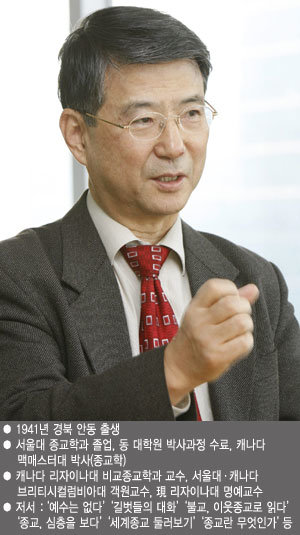 우리 사회에서 종교의 권위가 전만 못하다. 존경할 만한 종교 지도자도 찾기 어렵다. 오강남(74) 캐나다 리자이나대 명예교수는 “종교가 사회를 걱정하는 게 아니라 사회가 종교를 걱정해야 할 형편”이 된 한국 사회를 걱정하는 비교종교학자다. 그는 1971년 캐나다로 유학을 떠나 박사학위를 받고 줄곧 그곳에서 후학을 가르쳤다.
우리 사회에서 종교의 권위가 전만 못하다. 존경할 만한 종교 지도자도 찾기 어렵다. 오강남(74) 캐나다 리자이나대 명예교수는 “종교가 사회를 걱정하는 게 아니라 사회가 종교를 걱정해야 할 형편”이 된 한국 사회를 걱정하는 비교종교학자다. 그는 1971년 캐나다로 유학을 떠나 박사학위를 받고 줄곧 그곳에서 후학을 가르쳤다. ▼ 한국 기독교는 교수님이 비판하는 근본주의 성향이 강한 듯합니다. 성경에는 오류가 없다고 가르치곤 합니다. 기독교는 20세기 초 한국이 개명(開明)에 나섰을 때 도움을 줬습니다. 선교사들이 학교를 세웠고, 독립운동과 기독교가 연결됐습니다. 1970~80년대에는 그리스도교인이 폭발적으로 증가했습니다. 1970년대 10년 동안 교인 성장률이 1600%가 넘은 교회도 있습니다. 근본주의 신앙 덕분에 공격적 선교가 가능한 측면도 있었던 듯합니다.
▼ 한국 기독교는 교수님이 비판하는 근본주의 성향이 강한 듯합니다. 성경에는 오류가 없다고 가르치곤 합니다. 기독교는 20세기 초 한국이 개명(開明)에 나섰을 때 도움을 줬습니다. 선교사들이 학교를 세웠고, 독립운동과 기독교가 연결됐습니다. 1970~80년대에는 그리스도교인이 폭발적으로 증가했습니다. 1970년대 10년 동안 교인 성장률이 1600%가 넘은 교회도 있습니다. 근본주의 신앙 덕분에 공격적 선교가 가능한 측면도 있었던 듯합니다.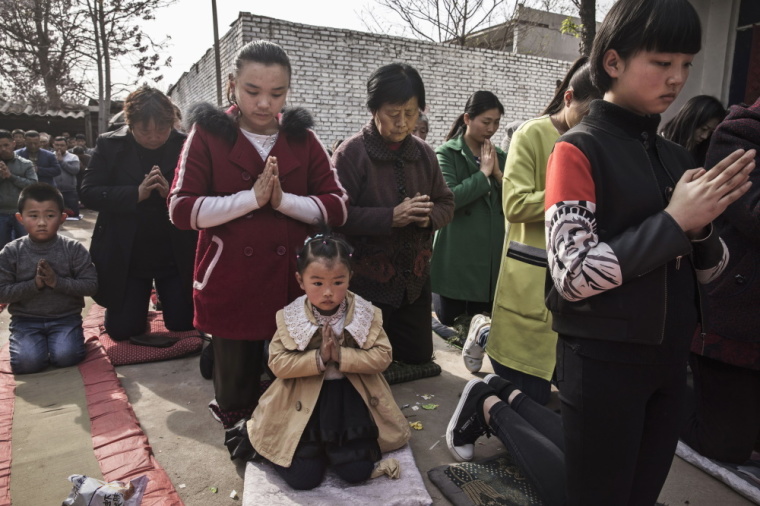 Chinese Catholic worshippers kneel and pray during Palm Sunday Mass during the Easter Holy Week
Chinese Catholic worshippers kneel and pray during Palm Sunday Mass during the Easter Holy Week 

